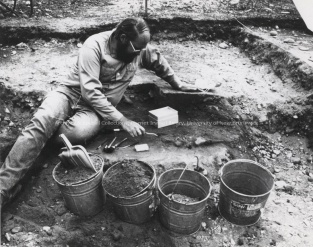Department of Anthropology
Previously named: History and Anthropology; Sociology and Anthropology.
Established: 1974
History: In 1940, the chair of the UNB History Department, Dr. Alfred G. Bailey, created an introductory course in Anthropology within the History Department that was the first of its kind in the Atlantic Provinces. The focus on the field of Anthropology grew over the subsequent fifteen years with more classes being added, and in the release of the academic calendar of 1954-55, although Dr. Bailey's chair was still titled 'History', the department in the calendar was named 'History and Anthropology'. In the years following, the department took on the name of 'History and Anthropology' and it remained this way until the academic year of 1968-69 when Anthropology was separated from History and moved to join the Sociology Department. Anthropology and Sociology only remained connected for five years and separated into stand-alone departments in 1974. The Department of Anthropology has remained a singular entity since 1974.
In the early 1940s, Anthropology was mainly an extension of the History Department that comprised a limited selection of four courses that addressed social anthropological topics useful for historical scholars. By 1954, when Anthropology first had its name included with History at the head of a department, the course selection had grown to six courses that still followed this same course of study in Social Anthropology. When Anthropology joined Sociology in 1968 the course offering had grown to ten courses and two courses that fell outside of social Anthropology (Archeology and Physical Anthropology) were part of the curriculum. The number of courses concentrating on physical aspects of Anthropology grew again when the autonomous department was created in 1974. That year there were thirty-four courses with more classes being offered in archeology and for the first time a field work-study archeology program was offered as well. In the 1990s the Archeology side of the department grew even more. There were seven courses offered in 1991 that had a concentration on physical Anthropology and by 1999 there were more than a dozen. From 2000 to 2012, the Anthropology Department has grown to include fifty-one courses with half of them focusing on the physical anthropological study. In the 2011-1012 academic year, Archeology was created as a specific, inter-departmental stream of study between Anthropology and Classics that falls directly under the auspices of the Anthropology Department and allows anthropology students the option of doing a major or honours in Archeology.
Physical location: Annex 'C'
Faculty: Arts
Notes: Dr. Bailey introduced the study of anthropology at U.N.B. because he believed that history students who did not have an opportunity to study in that field were at a disadvantage.
The year that a certain department was established can be a subjective figure. For the purpose of this wiki, the year that a department is considered first established is the first year it was listed in the academic calendar as an independent chair with no other affiliation, unless there is documentation to demonstrate otherwise.
Source(s):
- UNB Calendars (UA RG 86), 1940, 1954, 1960, 1969,1975, 1989, 1990-1999, 2000, 2010, 2011, 2012.
- UA Case 106; Section 4; Alfred G. Bailey, Origins of the Study of History in the University of New Brunswick.
- UA Case 78; Section 1; Annual Reports 1974-1975
--TonyGoss 5 February 2013 (ADT)
© UNB Archives & Special Collections, 2014
